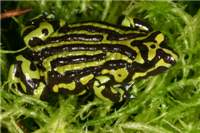Family
HylidaeGenus
PseudophryneSpecies
pengilleyi
Threats/Control Methods - Regional
Climate change, Chytrid fungus, increased UV radiation, over zealous controlled burn-offs earlier in the centuary may have altered some of the species natural native habitats. Livestock access in previous years is also thought to have impact on the natural habitat of the species,
For more information on the Chytrid fungus © Link to fact sheet http://www.deh.gov.au/biodiversity/invasive/publications/c-disease/
Frogs drink and breathe through their skin and are very sensitive to chemicals in their environment. Where possible, you should not handle frogs, as the natural bacteria on your hands or chemicals such as sunscreen can damage their skin and cause illness or death.
Local/Urban Actions
Breeding programs as well as site protection are ongoing, in an effort to promote the survival of the species. Also frog monitoring, under the Frogwatch Program, is run annually within the ACT, with monitoring done by volunteers from the general public over a two week period. The Frogwatch program provides training for community volunteers each October.For more information on Frogwatch contact:The ACT Frogwatch Coordinator, Ginninderra Catchment Group; Ph(02)62783309 oremail: [email protected]
Although it is unlike that this species will be attracted to the urban backyard it is possible to attract other frog species. Urban backyards can become suitable habitats for frogs through simple landscaping techniques. The Australian National University and the Ginninderra Catchment Group have developed a guideline to help you encourage frogs into your backyard called [Link - Creating a Frog Friendly Habitat in the ACT Community]
Distinguishing Features
A small frog covered in distinctive yellow/green and black stripes, in a pattern very similar to that found on a zebra. Although exceeding similar to the Southern Corroboree Frog (Pseudophyrne corroboree) in appearance small differences do exist. The Northern species has broken yellow-green and black stripes, while the Southern species has yellow and black continuous stripes and yellow and white spots on their chest. In general the yellow stripes on the Southern species are broader than that of the Northern species. In general the Southern species is also larger than the Northern.
Call sounds like a nasal Ah-rurkk ... urkk ...urkk
Common name/s
Northern Corroboree Frog
Similar Species
Southern Corroboree frog (Pseudophyrne corroboree), Brown Toadlet (Pseudophyrne bibroni), Southern toadlet (Pseudophyrne dendyi)
Distribution
Fiery Ranges, NSW, and Brindabella Ranges, ACT.
Country of Origin
Australia
Survey Techniques
Frogs are most easily detected by their call, the small size of this species making visual observation difficult without entering its habitat, posing risk to both the frog and the observer.
Conservation (Pet/Pest) Status - National
Conservation (Pet/Pest) Status - Regional
Listed as vulnerable under the NSW Threatened Species Conservation Act (1995).
LSCCES Population
Listed as Vulnerable under the Nature Conservation Act (1980).
Associated Vegetation Community
Like its Southern cousin Pseudophryne corroboree, the Northern Corroborree frog has two associated habitats, a breeding habitat such as low-lying heath and grassland, and a none-breeding habitat thought to be in woodlands.
Limiting Resources
Regular rainfall is required throughout autumn in order for the tadpoles of the species to survive. This species is only found at altitudes of 960-1520 metres.
Breeding
Very similar to the Southern Corroboree Frog (P.corroboree). The species calls from January through to march, breeds in summer and eggs hatch in autumn through to winter.
Behaviour
In winter, when in the none-breeding habitat, the species is thought to seek cover under leaf litter and logs .
P. pengilleyi is the less aggressive of the two Corroboree Frogs. P. corroboree males will issue threat calls to males entering their burrows, at the same time butting the opposing male frog, eventually ©tossing© the intruder out physically. On the other hand P. pengilleyi will continuously issues threat calls, only rarely having been observed to physically force out the opposing male.
Functional Group
Insectivore
Food Species
Mainly consists of a diet of ants (Formicidae), although other small invertebrates such as springtails (Collembola), mites (arcarina) and beetles (Coleoptera) make a small portion of the diet.
Predators
Not thought to have many, if any, predators in its natural environment.
Interesting Fact
Three call types have been identified for Corroboree Frogs an advertisement call and a courtship call, these are both used to attract females, and a threat call, used to frighten away other males.
References - (reader suitability of references, P=Primary teachers, S=Secondary students, T=Tertiary students and researchers)
Journals:
Osborne,W. (1989). Distribution, Relative Abundance and Conservation Status of Corroboree Frogs, Pseudophryne Corroboree Moore (Anura: Myobatrachidae). Aus.Wildl. Res. 16:537-47. T
Osborne,W. et al .(1996).Geographic variation in Corroboree Frogs,Pseudophryne corroboree Moore (Anura: Myobatrachidae): a Reappraisal supports Recognition of P. pengilleyi Wells & Wellington. Australian Journal of Zoology.44:569-87. T
Pengilley, R.(1971) . Calling and associated behaviour of some species of Pseudophryne (Anura: Leptodactylidae).J,Zool.,Lond. 163:73-92
http://www.abc.net.au/science/scribblygum/june2004/ T
Pengilley, R. (1971).The food of some Australian anurans (Amphibia).J,Zool., Lond.163:93-103. T
ACT Government, 1997. Corroboree Frog (Pseudophryne corroboree): A vulnerable species. Action Plan No. 6. Environment ACT, Canberra. T
Online Publications:
NSW Parks and Wildlife Service.(2001). Recovery Plan for the Southern Corroboree frog (Pseudophryne corroboree). NSW. Accessed 1 July 2006.
Available online through: www.npws.nsw.gov.au T
Researcher: Pippa Jaminon


 Top
Top Top
Top